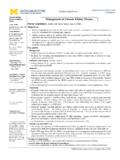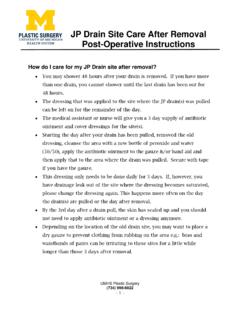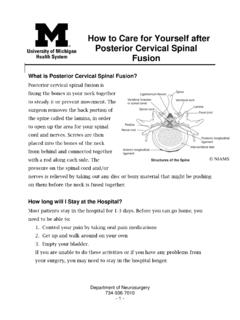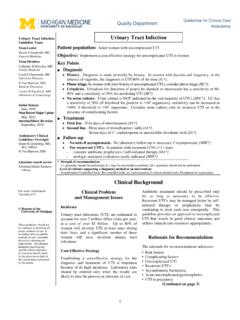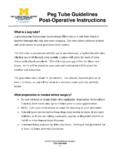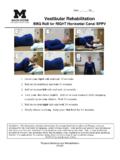Transcription of Brain Stents - University of Michigan
1 Brain Stents Artery Allies Department of Neurosurgery Department of Neurosurgery Brain Stents 2 Introduction Brain Stents are devices implanted in the brains of people with high risk conditions of the Brain arteries. Brain Stents save and improve lives every day, and University of Michigan specialists have developed great expertise in their use. Our team includes neurosurgeons and Neuro Interventional Radiologists (doctors with expertise in x ray guided Brain procedures) as well as nurses and other health professionals. We prepared this booklet to offer some clarity about these essential devices and their related aspects. Table of Contents: What is a When do we use Brain Stents ?..3 What is a Brain aneurysm?..3 What is intracranial stenosis?
2 6 What are the risks ?..7 How will having a stent in my Brain affect my life?..7 What kind of tests do I Blood In Taking clopidogrel (Plavix ) Stroke Warning Department of Neurosurgery Brain Stents 3 What is a stent ? A good way to think about a stent is like a retaining wall inside an artery. While Stents are not solid like an actual wall, they do what walls do by protecting an inner space from invaders or from being squeezed shut. Brain Stents are small tubes that range in diameter from about soda straw size down to a piece of spaghetti. The Stents are placed into Brain arteries to keep the blood flow strong. Stents are tubes made of wire mesh that is capable of expansion. The mesh is made of nitinol, a blend of nickel and titanium.
3 When it is first inserted into a patient s artery, the stent is packed within a wrapper. After the doctor advances the stent to the ideal position, he draws the wrapper back and the mesh expands to fit snugly against the vessel's inner wall. When do we use Brain Stents ? Stents have two main uses in the Brain . They are used to treat Brain aneurysms, and also to maintain blood flow in narrowing blood vessels. This second condition is called Intracranial Stenosis What is a Brain aneurysm? An aneurysm is a weak area in the wall of a Brain artery that bulges out like a balloon, usually in the shape of a berry or blister. An injury, infection or an inherited tendency may start an aneurysm that grows silently over time. Smoking and high blood pressure increase the risk of having an aneurysm.
4 Department of Neurosurgery Brain Stents 4 Saccular Aneyrsym Fusiform Aneurysm Eventually the bulge may stretch and cause the vessel s wall to get thinner and thinner until it breaks. This is called a rupture. A rupture may cause devastating Brain injuries that lead to major disability. Ruptured aneurysm. Aneurysm coiling is a procedure that can be very effective in preventing or limiting the impact of a rupture. Patients with aneurysms may benefit from this procedure if the aneurysm size or vessel size falls within a specific range. Department of Neurosurgery Brain Stents 5 For aneurysm coiling, the surgeon or radiologist inserts a very thin, highly flexible tube called a catheter into an artery, usually in the groin. The doctor threads the catheter through the arteries until it reaches the aneurysm.
5 The doctor then uses the tube to deliver coils into the aneurysm until it is filled with them. These coils reduce blood flow and cause a clot to form, sealing the aneurysm from inside. Most often Stents are used to support this coiling process when the aneurysm has an unusual shape. If an aneurysm has a wide neck, the coils needed to seal it can easily float out. This not only means that the aneurysm is not getting fixed, but there is also a danger of traveling coils causing strokes deeper within the Brain . When a stent is first positioned at the base of the aneurysm, it can act as a kind of backstop . The coils are then fed through the mesh and into the aneurysm. In this way the stent secures the coils, making sure they stay in place. Using this backstop technique makes it possible to treat aneurysms that were often untreatable in the past.
6 To view a video demonstration of how the stent is deployed visit: and type the keyword coiling in the search box. Treating an aneurysm with coils and a stent Department of Neurosurgery Brain Stents 6 stent helps to keep artery open What is Intracranial Stenosis? Stenosis means narrowing . Intracranial stenosis occurs when plaque builds up within an artery that supplies blood to Brain tissue. This buildup causes narrowing of the artery and can lead to stroke. Some patients who have intracranial stenosis have good results with medications like aspirin and blood thinners and by making lifestyle changes. stent placement is recommended for those having symptoms from severe intracranial stenosis that have not been improved by medical treatment. Severe intracranial stenosis is defined as 70% blockage or more.
7 Treating intracranial stenosis with Stents is often done along with cerebral angioplasty. Cerebral angioplasty is another procedure that begins with a doctor routing a catheter into an affected Brain artery. In this case, the angioplasty catheter is one that has an expandable balloon near its tip. Once the catheter is positioned within the area of stenosis, the physician expands the balloon, pressing back the narrowed arterial walls and improving the passage of blood. After this treatment, a stent may be placed to keep the passage securely open. The stent s more rigid form prevents cave-ins or re-closing the artery from surrounding pressure. Department of Neurosurgery Brain Stents 7 What are the risks ? Just like any medical procedure, Brain stent implantation can carry risks of complications.
8 These include but are not limited to: artery puncture stent movement damage to the lining of the vessel causing an artery dissection bleeding into the Brain stroke from artery blockage When considering these risks , doctors and patients must weigh them against the risks of not having a stent placed. For example: patients with 70% to 99% stenosis that are treated with medications alone have a high rate of stroke. Untreated aneurysms have the potential to rupture as discussed above. We encourage you to talk with your doctor about the options, risks , and potential benefits of Brain Stents in your individual situation. Brain Stents cannot be implanted in people who: are not able to take blood-thinning drugs to help prevent blood clots have blockages in arteries that cannot be accessed with a catheter because of their anatomical structure How will having a stent in my Brain affect my life?
9 Stents can improve and even save lives, but having a stent does bring some new precautions into the life that s saved. Having a stent can make you prone to bleeding. Caution is crucial. Since a body s usual reaction to a stent would be to coat it with blood clots, your doctor will prescribe drugs to keep its surface clear. These medications, Department of Neurosurgery Brain Stents 8 also called blood thinners will include aspirin and Plavix (cloipdogrel), and they increase your risks for bleeding anywhere in the body. Blood thinners may be needed for a long or short time period. It is important that you are faithful in taking them as prescribed. Interrupting this therapy will drastically increase your risks of a stroke. (A list of stroke signs and symptoms is available at the end this booklet).
10 While you are on these medications, avoid situations that increase your risks for cuts or trauma. Be quick to have any injuries to the head checked out thoroughly. And be sure any other doctor or dentist you are seeing knows that you are taking these medications. Refer to Appendix 1 of this booklet to see a detailed list of things to keep in mind while taking Plavix . This stent is an implant, carry your card. Having an implanted device brings questions and responsibilities. Many patients wonder Will I set off metal detectors? or Will my stent rust? or Will I be in danger having an MRI? Since current Stents are made of nitinol (a blend of nickel and titanium) the answer to all these questions can be no.
